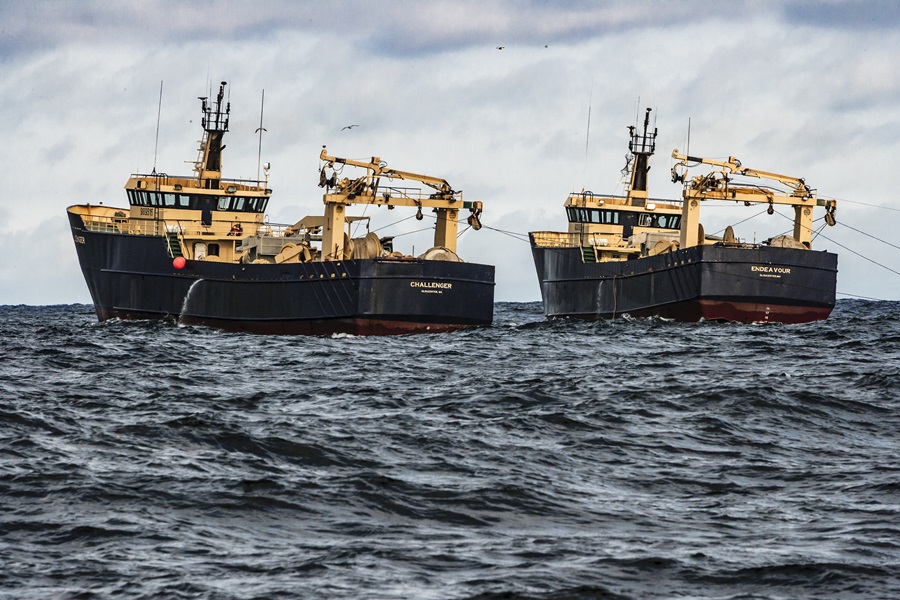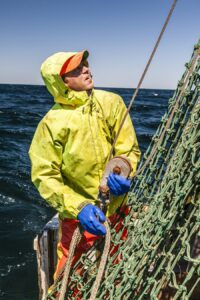The marine ecosystem around Cape Cod is built on the backs of Atlantic herring. These baitfish school in massive numbers, providing food for marine mammals, seabirds, and large fish like cod. Their eggs, which they lay in the fall and are dense enough in spots to carpet the ocean floor, are food for crabs and other bottom-dwelling animals.
They are also a $4.5-million fishery, used as bait for lobster traps, turned into canned sardines, and sold, frozen or salted, overseas. But with the Atlantic herring population in a steep decline, and the most recent attempt at a rule to protect the fish thwarted, Cape Cod fishermen are advocating for new ways to protect the species.

According to the Northeast Fisheries Science Center’s most recent stock assessment, as of 2021, the herring population was at 21 percent of what it ought to be. The goal is a number that allows for the largest sustainable fishery, known as the biomass target; anything below 50 percent of that target is classified as “overfished.”
To make matters worse, the herring “recruitment rate” — that is the number of herring that have successfully hatched and are in their first year of life — has been below average since 2013.
In recent years, much of the blame for this decline has been placed on midwater trawlers. These boats drag large nets, often larger than football fields, scooping up massive volumes of fish at once. A rule that regulated these boats and tried to address the herring’s importance to other stocks was introduced by NOAA Fisheries in 2021.
That rule was broadly popular with Cape Cod small-boat fishermen, but it was struck down in court the following year.
Now, the New England Fishery Management Council (NEFMC) is working on new regulations aimed at tackling herring overfishing in a different way. This time, the proposed rule hinges on the need to protect the river herring that school with the oceangoing species.
The scoping process, which concluded at the end of April, gathered input from stakeholders including members of the Cape Cod fishing fleet. And it appeared to establish a clear consensus that regulations are needed and that they should focus particularly on midwater trawlers.
Loss of a Linchpin Stock
New England’s commercial Atlantic herring fishery was established in the late 19th century, but it reached its peak in the late 1960s when foreign vessels moved into the fishing grounds at Georges Bank. These vessels scooped up an estimated 500,000 tons of herring a year, massively depleting the stock.
After the 1976 Magnuson-Stevens Act banned foreign vessels in federal waters, Atlantic herring began to recover. But they went into decline again in the early 2000s, and that decline has continued since.
“The stock is devastated at this point,” said Bill Amaru, a groundfisherman from Chatham who owns the F/V Paladin.

The herring’s decline poses a significant threat to the health of other fisheries, especially groundfish like cod, pollock, haddock, and winter flounder. “Herring are the linchpin stock for all the other fishes that come above them,” Amaru said. Without them, those fisheries are likely to collapse.
Herring are also crucial to the broader health of the ocean because large predators subsist on them. “Sharks, seabirds, tuna, groundfish, whales — everyone really relies on herring,” said Aubrey Ellertson Church, policy manager at the Cape Cod Commercial Fishermen’s Alliance.
Big Boats Have a Big Effect
Many fishermen and scientists blame the two-decade dropoff in the herring population on midwater trawlers. These vessels began operating in New England in the mid-1990s, dragging nets behind them to catch huge volumes of herring. They often work in tandem, stringing one net between two boats to cover large areas in a technique known as pair trawling. According to Church, they mostly operate out of Gloucester, New Bedford, and coastal Maine and New Hampshire.
The trawlers’ capacities make overfishing far easier, especially in the fall, when herring congregate to mate and reproduce. Passing a midwater trawl through here, said Church, could wipe out an entire school, which in turn drives away important larger fish. “A big boat goes and tows up tons of bait, then there’s no tuna going to be around,” she said.
The trawler nets’ mesh can be as small as three inches, and that’s another problem, said Amaru. “If you’ve got marine mammals or turtles or anything else, they’re dead,” he said.
“They catch plenty,” Amaru added. “I’ve seen it with my own eyes.”
To address the herring’s decline, NOAA Fisheries introduced an amendment to the Atlantic Herring Fishery Management Plan in January 2021. The rule, Amendment 8, altered the herring catch limit and prohibited midwater trawling for herring in all inshore federal waters in the Northeast. That rule established a 20-nautical-mile buffer zone on trawling activity around Cape Cod.
The change was good for the herring and for Cape Cod fishermen, said Church. It gave herring a space where they would be safe from high-volume capture to help the population recover. And it gave smaller boats a space to fish for herring using less destructive methods without competing with the trawlers.
The rule was overturned in March 2022 by U.S. District Court Judge Leo T. Sorokin, citing a lack of scientific evidence for localized depletion of stocks and links to trawlers. The lawsuit was brought by a group of herring and mackerel fishing businesses with a confusing name: the Sustainable Fisheries Coalition.
The next year, things got worse: NOAA Fisheries suspended the industry-funded monitoring program for the herring fishery for budgetary reasons. This drastically reduced the number of observers on ships who collect data on bycatch and fishing practices. Losing much of this data makes studying the effects of these trawlers even harder.

Herring trawlers, Amaru said, “should have 100-percent observer coverage.” He admits he doesn’t like having observers on board his boat, but “if one group is going to have it, I don’t see why they shouldn’t.”
What the NEFMC is working on now is Amendment 10. During the scoping process, some 80 fishermen, conservationists, whale watch captains, Wampanoag elders, and concerned locals spoke at six public meetings. Only five speakers opposed expanded regulations.
Nantucket fisherman Pete Kaizer called the herring situation “a natural disaster,” saying “if I was trying to eradicate a species and destroy great fishing habitat, a small mesh midwater trawler with no observer coverage would be the perfect gear type.”
Jack Patrician, a Gloucester charter fisherman, said that a midwater trawler “will turn a beautiful ecosystem into a dead zone in just a matter of hours.”
Amaru spoke, too, talking about his time on the NEFMC in the mid-1990s and how the herring fishery has developed since then. “We had no idea that we were going to be looking at the kind of power that this fleet has developed into,” he said. “It’s really a shame that the Fisheries Service allowed it to grow the way it did.”
The River Herring’s Role
Many at the NEFMC scoping meetings, from the Orleans Shellfish and Waterways Improvement Advisory Committee to the Wampanoag Tribe of Gay Head (Aquinnah), mentioned the need to protect river herring as an important reason for regulating the Atlantic herring fishery.
These fish spend most of their lives at sea and migrate up streams two or three times in their lives to lay their eggs in sheltered ponds. They are historically an important Cape Cod fishery, but as the Independent reported on March 27, river herring stocks are extremely low — the population has been unable to recover in the years since a harvesting moratorium was enacted in 2006.
One theory about that problem has to do with the fact that river herring school with Atlantic herring at sea, putting them in the path of midwater trawlers’ indiscriminate harvesting.
“It’s difficult to avoid catching river herring that are schooling together with the Atlantic herring,” said Jo Ann Muramoto, director of science programs at the Association to Preserve Cape Cod.

Muramoto runs the association’s river herring monitoring program, and she noted that, despite significant restoration attempts along streams and in spawning ponds, their runs appear to have peaked in the early 2010s; since then, with few exceptions, they have declined.
There are other factors likely contributing to river herring declines, such as dammed rivers and eutrophication. Those problems are being addressed, said Muramoto. Meanwhile, “The main cause of [river] herring decline that is not yet well controlled is overfishing at sea.”
Millions of dollars are being spent to restore river herring in Massachusetts, she said, and “overfishing at sea is in direct conflict with this huge landside investment.”
“It is not conceivable to me, as a Wampanoag elder, that the state of Massachusetts and the federal government can OK our sustenance food for lobster bait,” said Wampanoag Tribe of Gay Head (Aquinnah) Elder Kristina Hoak at the Buzzards Bay meeting on March 27. “You have no right to allow the interference of boats that suck up the herring that are coming to spawn.”
A Long Way to Go
Janice Plante, a public affairs officer for NEFMC, said the meetings are only the first step in the process of regulating herring trawlers. Next, NEFMC staff will develop alternatives to current management strategies; when those are approved by the council itself, they’ll go to the public for comment — Plante estimates that will happen early next year.
Then, assuming the council adopts a new regulation, it will be submitted to NOAA Fisheries for review, followed by more public comments and any necessary changes before any new rule becomes reality.
In other words: “We are still at the very, very early stages of the amendment process,” Plante said.
Despite the slow process, Amaru believes it’s a cause worth fighting for. The Outer Cape, he said, used to be one of the largest herring fisheries in the country. Recovering it is going to require Cape Cod fishermen to be vocal. “I don’t see an advantage to our goals by being standoffish and close-mouthed,” he said.



